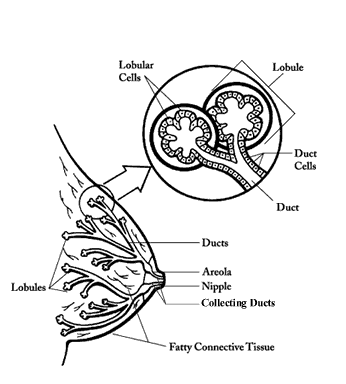

|
||||||||||
|
|
||||||||||

|
| What is Breast Cancer?
Breast cancer is the most common cause of cancer in women and the second most common cause of cancer death in women in the U.S. While the majority of new breast cancers are diagnosed as a result of an abnormality seen on a mammogram, a lump or change in consistency of the breast tissue can also be a warning sign of the disease. Heightened awareness of breast cancer risk in the past decade has led to an increase in the number of women undergoing mammography for screening, leading to detection of cancers in earlier stages and a resultant improvement in survival rates. Still, breast cancer is the most common cause of death in women between the ages of 45 and 55. Although breast cancer in women is a common form of cancer, male breast cancer does occur and accounts for about 1% of all cancer deaths in men. Research has yielded much information about the causes of breast cancers, and it is now believed that genetic and/or hormonal factors are the primary risk factors for breast cancer. Staging systems have been developed to allow doctors to characterize the extent to which a particular cancer has spread and to make decisions concerning treatment options. Breast cancer treatment depends upon many factors, including the type of cancer and the extent to which it has spread. Treatment options for breast cancer may involve surgery (removal of the cancer alone or, in some cases, mastectomy), radiation therapy, hormonal therapy, and/or chemotherapy. With advances in screening, diagnosis, and treatment, the death rate for breast cancer has declined by about 20% over the past decade, and research is ongoing to develop even more effective screening and treatment programs A women’s breast is made up of glands that make breast milk (called lobules), ducts (small tubes that carry milk from the lobules to the nipple), fatty and connective tissue, blood vessels, and lymph (pronounced limf) vessels. Most breast cancers begin in the cells that line the ducts (ductal cancer), some begin in the lobules (lobular cancer), and a small number start in other tissues.
|
| TOP |
|
It can be hard to understand some of the words your health care team uses to talk about breast cancer. Here are the key words used to describe breast cancer: Carcinoma: This is a term used to describe a cancer that begins in the lining layer of organs such as the breast. Nearly all breast cancers are carcinomas (either ductal carcinomas or lobular carcinomas). Adenocarcinoma: An adenocarcinoma is a type of cancer that starts in glandular tissue (tissue that makes and secretes a substance). The ducts and lobules of the breast are glandular tissue (they make breast milk), so cancers starting in these areas are sometimes called adenocarcinomas. Carcinoma in situ: This term is used for the early stage of cancer, when it is still only in the layer of cells where it began. In breast cancer, in situ means that the cancer cells are only in the ducts (ductal carcinoma in situ) or lobules (lobular carcinoma in situ). They have not spread into deeper tissues in the breast or to other organs in the body. They are sometimes referred to as non-invasive breast cancers. Invasive (infiltrating) carcinoma: An invasive cancer is one that has already grown beyond the layer of cells where it started (unlike carcinoma in situ). Most breast cancers are invasive carcinomas -- either invasive ductal carcinoma or invasive lobular carcinoma. Sarcoma: Sarcomas are cancers that start from connective tissues such as muscle tissue, fat tissue or blood vessels. Sarcomas of the breast are rare. |
| TOP |
|
There are many types of breast cancer, though some of them are very rare. Sometimes a breast tumor can be a mix of these types or a mixture of invasive and in situ cancer. Ductal carcinoma in situ (DCIS): This is the most common type of non-invasive breast cancer. DCIS means that the cancer is only in the ducts. It has not spread through the walls of the ducts into the tissue of the breast. Nearly all women with cancer at this stage can be cured. Often the best way to find DCIS early is with a mammogram. Lobular carcinoma in situ (LCIS): This condition begins in the milk-making glands but does not go through the wall of the lobules. Although not a true cancer, having LCIS increases a woman's risk of getting cancer later. For this reason, it's important that women with LCIS make sure they have regular mammograms. Invasive (infiltrating) ductal carcinoma (IDC): This is the most common breast cancer. It starts in a milk passage or duct, breaks through the wall of the duct, and invades the tissue of the breast. From there it may be able to spread to other parts of the body. It accounts for about 8 out of 10 invasive breast cancers. Invasive (infiltrating) lobular carcinoma (ILC): This cancer starts in the milk glands or lobules. It can spread to other parts of the body. About 1 out of 10 invasive breast cancers are of this type. Inflammatory breast cancer (IBC): This uncommon
type of invasive breast cancer accounts for about 1% to 3% of all
breast cancers. Usually there is no single lump or tumor. Instead,
IBC makes the skin of the breast look red and feel warm. It also
gives the skin a thick, pitted appearance that looks a lot like
an orange peel. The affected breast may become larger or firmer,
tender, or itchy. Sources: The American Cancer Society and Medicine.Net For additional information on breast cancer, treatment and surgical options please visit the links provided to the right of this page. |
| TOP |
| Developed by and hosted at the University of Nebraska Medical Center Fred & Pamela Buffett Cancer Center |
 |
|
